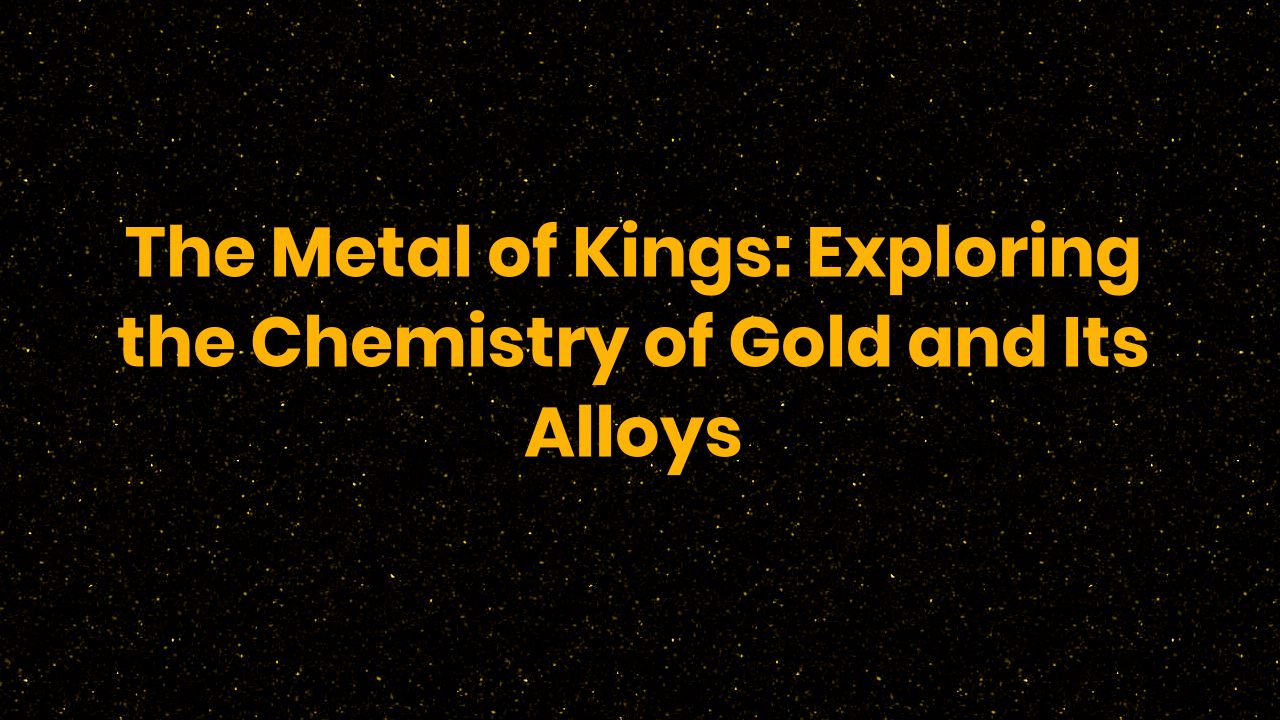
Table of Contents
Metal of Kings: Exploring the Chemistry of Gold and Its Alloys
Introduction: Gold as a Symbol of Wealth and Power
Since ancient times, gold has been valued for its beauty and rarity, and has been used to symbolize wealth and power. From the pharaohs of ancient Egypt to modern banking and investing, gold has been a constant presence in human history. Its scarcity and durability make it an ideal material for currency, jewelry, and a variety of industrial applications. Despite its ubiquitous presence in human culture, gold’s unique chemical properties make it a fascinating subject for scientific study.
Gold’s Unique Chemical Properties
Gold is one of the most unreactive of all the chemical elements, and is virtually indestructible. Its resistance to corrosion and tarnishing make it an ideal material for jewelry and other decorative objects. Gold is also an excellent conductor of electricity, and is used in a variety of electronic applications. These unique properties are due to gold’s electronic structure, which allows it to form stable compounds and resist chemical reactions.
The Composition of Gold Alloys
Pure gold is very soft and malleable, making it unsuitable for many applications. To increase its hardness and durability, gold is often alloyed with other metals such as copper, silver, and nickel. The composition of gold alloys can vary widely, depending on the intended application. Some alloys are designed for maximum durability, while others are optimized for their color or other aesthetic properties.
How Gold Alloys Are Used in Jewelry
Gold alloys have been used in jewelry making for millennia. The addition of other metals can enhance the color and durability of gold, as well as making it more suitable for intricate designs. White gold, for example, is an alloy of gold, nickel, and zinc that is popular in modern jewelry. The heaviest gold alloy used in jewelry is 22K which contains 91.6% gold and 8.4% other metals, usually copper or silver.
The Industrial Applications of Gold Alloys
Gold alloys are also used in a variety of industrial applications, including electronics, dentistry, and medical implants. Gold’s conductivity and resistance to corrosion make it an ideal material for electronic components such as circuit boards and connectors. Its biocompatibility and resistance to tarnishing make it an ideal material for dental restorations and medical implants.
The History of Gold Mining
Gold mining has been a part of human history for thousands of years. The ancient Egyptians were among the first to mine gold, while the Romans and Greeks also valued the metal for its beauty and rarity. The discovery of gold in the Americas during the 19th century led to the California Gold Rush and the development of large-scale mining operations in the western United States.
Environmental Impacts of Gold Mining
Despite its economic importance, gold mining can have significant environmental impacts. Mining operations can disrupt local ecosystems, pollute waterways with toxic chemicals, and generate large amounts of waste rock and tailings. Modern mining practices have sought to mitigate these impacts through better waste management and reclamation efforts.
Future of Gold Mining and Sustainability
As global demand for gold continues to grow, mining companies are under increasing pressure to adopt more sustainable practices. This includes reducing their environmental impact, improving working conditions for miners, and ensuring that the communities affected by mining operations receive a fair share of the benefits. New technologies, such as advanced ore processing techniques and renewable energy sources, offer promise for a more sustainable future for the gold mining industry.
The Economic Importance of Gold
Gold is one of the most valuable and sought-after commodities, with a long history as a store of value and a medium of exchange. Gold remains an important reserve asset for central banks and plays a key role in global financial markets. The price of gold is influenced by a variety of factors, including supply and demand, political and economic events, and inflation expectations.
The Enduring Appeal of Gold
Despite its many industrial and practical applications, gold remains prized for its beauty, rarity, and association with wealth and power. From ancient times to the modern era, gold’s enduring appeal has made it one of the most fascinating and valuable of all the chemical elements. As our understanding of gold continues to evolve, this beloved metal will continue to play a vital role in our lives and in the global economy.
Summary and Conclusion
In summary, gold is a fascinating metal with unique chemical properties that make it a valuable material for a wide range of applications. Gold alloys have been used in jewelry making and other decorative arts for millennia, while its conductivity and resistance to corrosion make it ideal for electronics, dentistry, and medical implants. Gold mining has played an important role in human history, but also has significant environmental impacts that must be managed responsibly. Looking ahead, the future of gold mining will be shaped by advancements in technology and a growing focus on sustainability. Despite these challenges, gold’s enduring appeal as a symbol of wealth and power ensures that it will continue to play a central role in human culture and commerce for generations to come.





